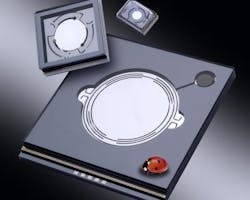Fast silicon micromirrors improve laser cutting and welding
New silicon laser-beam-steering micromirrors jointly developed by engineers at the Fraunhofer Institute for Silicon Technology ISIT (Itzehoe, Germany) and the Fraunhofer Institute for Material and Beam Technology IWS (Dresden, Germany) are robust enough to handle the high laser powers needed for laser welding and cutting. The flexure-based microelectromechanical systems (MEMS) steering mirrors, which are etched from silicon wafers, can handle powers in the kilowatt range, rather than the few milliwatts of conventional MEMS steering mirrors.
The high-power operation is possible due to a new protective coating developed in the cooperative project, as well as a new type of evacuated mirror mount.
Frequencies to 0.1 MHz
A major advantage of the thin MEMS mirrors is that they can be swiveled back and forth at extremely high speeds, reaching frequencies of up to 0.1 MHz. This allows the laser energy to be distributed on the workpiece much more effectively than with conventional laser systems, whose mirrors operate at only around 1 kHz.
If a beam-steering laser mirror for materials-processing applications swivels slowly, the beam energy cannot be distributed and dosed as effectively at the weld. "By contrast, rapid oscillation of the laser beam allows us to distribute the heat and adjust it to the respective processing task much more effectively," says Andreas Wetzig, a specialist in the laser ablation and cutting department at Fraunhofer IWS.
As demonstrated in lab experiments, the MEMS mirrors open up all kinds of possibilities, for example in cutting, welding, and surface hardening. "We can weld together aluminum and copper, for example, and use the heat input to precisely control which metal heats up more and thus makes up more of the melt," says Wetzig. The mirrors also make it easier to weld aluminum alloys alone. At present, aluminum weld seams are often porous, because certain substances outgas from the alloys and form bubbles during the welding process. With the micromirror, heat input can be controlled so that the melt remains liquid until the substances have completely outgassed.
Improves solid-state-laser cutting
Although the solid-state lasers currently available can cut metals very well, the cut edges do not match up to the quality habitually achieved when cutting with CO2 lasers. Targeted heat input using MEMS mirrors reduces edge roughness and avoids burr formation on the underside of the cut edge.
The ability of the new MEMS micromirrors to work with high laser powers is due not only to their special reflective coating, but also to their unusual size. Normally, MEMS mirrors have a diameter of 1 to 2 mm; The new MEMS mirrors have diameters of up to 20 mm, enabling them to handle even lasers with larger beam diameters and significantly higher output.
For the developers, the challenge consisted in achieving high frequencies despite the size. "To address this issue, we operate the mirrors in air-evacuated vacuum pods in order to minimize attenuation of the oscillating mirror," says MEMS mirror expert Ulrich Hofmann at Fraunhofer ISIT.
At Laser Munich
Hofmann and his colleagues will be exhibiting several of the new mirrors at the LASER World of Photonics (22 to 25 June, 2015; Munich, Germany).
About the Author
John Wallace
Senior Technical Editor (1998-2022)
John Wallace was with Laser Focus World for nearly 25 years, retiring in late June 2022. He obtained a bachelor's degree in mechanical engineering and physics at Rutgers University and a master's in optical engineering at the University of Rochester. Before becoming an editor, John worked as an engineer at RCA, Exxon, Eastman Kodak, and GCA Corporation.

